
Castle in Muromtsevo (B&W version)
Originally uploaded by O1e9

Senlis - Oise (France).
En 1065, l’église fut consacré en l’honneur de la Sainte trinité, de la vierge Marie, de Saint Jean-Baptiste et de Saint-Vincent. Le monastère fut désigné par le nom d’Abbaye Royale de Saint-Vincent et donna son nom au faubourg dans lequel il était situé. Ce sont les chanoines de l'ordre de Saint-Augustin qui s'installèrent.
In 1065, the church was dedicated in honour of the Holy trinity, of the Virgin Mary, of Saint Jean-Baptiste and of Saint Vincent. The monastery was indicated by the name of Saint Vincent's royal Abbey and gave its name to the suburb in which it was situated. It is the canons of the order of Saint Augustin that settled down.

The statue of Sir Francis Drake by Joseph Boehm was placed here in 1884.It is a copy of the original in his home town of Tavistock.
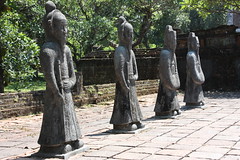
(Similar to the Teracotta Warriors in China, these figures stand guard within Emperor Tu Duc's tomb complex.)
Prince Nguyễn Phúc Hồng Nhậm was born on 22 September 1829, and succeeded his father on the throne, with the reigning title of Tự Đức. His father, Thiệu Trị had passed over his more moderate eldest son, Hồng Bảo, to give the throne to Tự Đức, known for his staunch Confucianism and opposition to foreigners and innovation. The Nguyễn Dynasty were not particularly popular and opposition rallied to Hồng Bảo, who led a rebellion against his brother. Tự Đức suppressed the rebellion and imprisoned his brother, who killed himself.
Tự Đức continued the policies of his predecessors, shutting Vietnam off from the outside world and refusing all efforts to modernise the country. Accounts of his personal life show a gentle and educated man, but his policies brought on conflict with Europe that Vietnam could not win. He oppressed all foreigners in Vietnam, especially the Christian community, calling their religion a "perverse doctrine". The Christian mandarin Nguyễn Truong To, tried to convince Tự Đức that this was a suicidal policy, but he did not listen, confident that France was too involved with the chaos in Europe in 1848 to respond, but he was mistaken.
France responded with a large military expeditionary force. The Nguyễn army fought bravely for some time, but their antiquated weapons and tactics were no match for the French, who suffered more from the climate and disease than from enemy resistance. With French forces moving closer, Tự Đức called upon his Chinese over-lord, the Qing Great Khan, for help and so ensued the Sino-French War. The fighting around Hanoi against China and the Black Flag pirates ended with France victorious and the Chinese gave up their position as feudal masters of Vietnam and recognised France as the ruling power over the region - a significant moment in the history of the region.
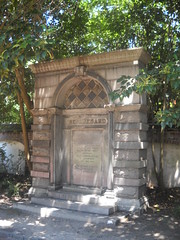
This memorial is dedicated to General Pierre Beauregard who was a Confederate General in the Civil War. It is located in Washington Park in Charleston, SC. Beauregard was stationed in Charleston when the Confederates seized Charleston.

This was the booth President Lincoln was sitting in on April 14, 1865 when he was shot and killed by John Wilkes Booth. Located inside Fords Theater.
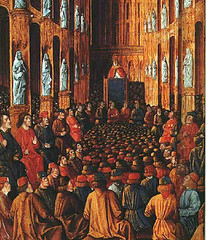
REMEMBER TO CHECK OUT THE MAIN BLOG AT summoning-ifrit.tumblr.com - many more photos, plus videos, links, and more.
Illumination of Pope Urban II at the Council of Clermont of 1095, from the Livre des Passages d'Outre-mer, c. 1490. Note the scene has been anachronistically placed in a late Gothic setting.
The Council of Clermont was a mixed synod of ecclesiastics and laymen of the Catholic Church, which was held from November 18 to November 28, 1095 at Clermont, France. Pope Urban II's speech on November 27 was the starting point of the First Crusade.
In 1095 the Byzantine emperor Alexius I Comnenus sent envoys to the west requesting military assistance against the Seljuk Turks. The message was received by Pope Urban II at the Council of Piacenza; later that year, in November, Urban called the Council of Clermont to discuss the matter further. In convoking the council, Urban urged the bishops and abbots whom he addressed directly, to bring with them the prominent lords in their provinces.
The Council lasted from November 19 to November 28, and was attended by about 300 clerics from throughout France...
...On November 27, Urban spoke for the first time about the problems in the east, as he urged Western Christians fight against the Muslims who had occupied the Holy Land and were attacking the Eastern Roman Empire. - enWikipedia

A page from the book, 'San Francisco, West Coast Metropolis,' published in 1939.
This is a cool photo. It shows City Hall reflected in the windows of the Opera House, where the San Francisco Symphony used to perform. The board shows the name of Pierre Monteux, who was the conductor from 1935 to 1952. Today, the symphony plays next door, at Davies Symphony Hall.
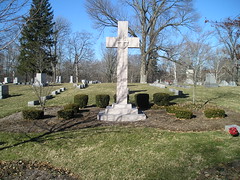
He was a lieutenant for the US Army during WWI. He also ran for President in 1940 although he had never held another political job. He ran on the Republican ticket and received over 22 million votes, more then any other Republican before him. However though, he lost the election to Franklin Roosevelt in a land slide, 449 to 82. He is buried at East Hill Cemetery in Rushville, In.
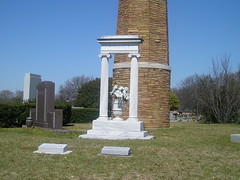
He was the 48th Governor of Alabama. He ran for President in 1968 finishing 3rd and losing to Richard Nixon. He is buried in Greenwood Cemetery in Montgomery, Al.

Donald MacGilleasbuig gravestone at Finlaggan Castle, faintly reminiscent of the lovely Isle of Lewis chess pieces.
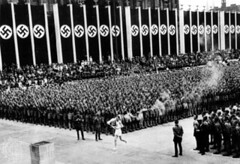
The modern convention of moving the Olympic Flame via a relay system from Olympia to the Olympic venue began with the 1936 Summer Olympics in Berlin, Germany. The relay, captured in Leni Riefenstahl's film Olympia, was part of the Nazi propaganda machine’s attempt to add myth and mystique to Adolf Hitler’s regime. Hitler saw the link with the ancient Games as the perfect way to illustrate his belief that classical Greece was an Aryan forerunner of the modern German Reich.
http://en.wikipedia.org/wiki/1936_Summer_Olympics
http://en.wikipedia.org/wiki/Leni_Riefenstahl
http://en.wikipedia.org/wiki/Olympia_(1938_film)
http://en.wikipedia.org/wiki/Aryan_race
source:
http://www.flickr.com/photos/summoning_ifrit/

The four pence is the oldest English coin ever found in Canada and dates to between December 1560 and October 1561.
Cupids, Newfoundland and Labrador
Archaeological dig of John Guy's Colony founded in 1610.
www.baccalieudigs.com
400th Anniversary of Cupids Cove
www.cupidscovechatter.com

Monument of Fallen Shipworkers, Solidarności sq., Gdańsk, June 4, 2006
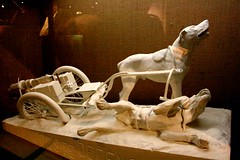
Europe Europa
Belgique België Belgium Belgien Belgica
Bruxelles Brussel Brussels Brüssel Bruxelas
Musée de l'Armée (Cinquantenaire)
Statuette : Chien mortellement blessé alors qu'il accomplissait sa mission. Remarquez les roues enfoncées dans la gadoue

From the exhibit: "This is the mummy of Hornedjitef, and Egyptian priest who was buried inside two different coffins. Examining his body using CAT scans and X-Rays revealed that he suffered from arthritis and osteoporosis, suggesting he was a mature man when he died. The embalmers have placed four packages inside his torso, probably his lungs, liver, stomach and intestines. He lived over a thousand years after Tutankhamen and Ramestes the Great at a time when Egypt was ruled by Greek kings."

Hier befindet sich der grösste Kreuzgang der Schweiz. Er ist teils romanisch 12. Jh., teils gotisch 13. Jh. und umschliesst den romantischen, bezaubernden Kreuzganggarten, den so genannten «Junkerfriedhof», in dem von 1582 - 1874 hohe Schaffhauser Magistraten, wie Bürgermeister, Ratsherrn, Pfarrer und andere verdiente Bürger- und Bürgerinnen beigesetzt wurden.
Here is the largest cloister in Switzerland. It is partly Romanesque 12th Century, partly Gothic 13th Century and embraces the romantic, enchanting cloister garden, the "so-called Squire Cemetery" in which from 1582 - 1874 Schaffhausen high magistrates, were buried as mayors, councilors, ministers, and other deserving citizens and citizens.
see also:
www.flickr.com/photos/eduard_buerge-rafz/4353965648/

A bust ofBrennus, who led the Gauls against the Romans in theBattle of Allia.
The Battle of the Allia was a battle of the first Gallic invasion of Italy. The battle was fought near the Allia river: the defeat of the Roman army opened the route for the Gauls to sack Rome. It was fought in 390/387 BC.
photo by Med
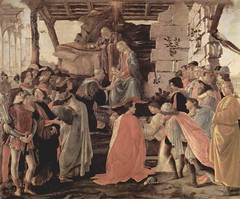
Very famous Renaissance painting,the Adoration of the Magi bySandro Botticelli, c. 1475
The adoration of the magi was a popular theme in Renaissance art, and in Botticelli's version he has placed members of theMedici family as well as himself (farthest on the right, in yellow, looking at the viewer) in the scene.
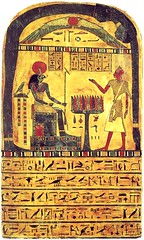
The Stele of Revealing
The
Stele of Ankh-ef-en-Khonsu i (also known as the Stele of Revealing) is a
painted, wooden offering stele, discovered in 1858 at the mortuary temple of
Hatshepsut
at Dayr al-Bahri...It
was made for the
Montu-priest
Ankh-ef-en-Khonsu
i, and was discovered near his coffin ensemble of two sarcophagi and two
anthropomorphic inner coffins. It dates to circa 680/70 BCE, the period of the
late
Dynasty 25/early
Dynasty 26...On the front Ankh-ef-en-Khonsu i as a priest of Montu can be
seen; he is presenting offerings to the falcon-headed god
Re-Harakhty ("Re-Horus
of the Two Horizons"), a synchronistic form of the gods
Ra and
Horus, who is
seated on a throne. The symbol of the west, the place of the Dead, is seen
behind Re-Harakhty. Above the figures is a depiction of
Nut, the
sky goddess who stretches from horizon to horizon. Directly beneath her is the
Winged Solar
Disk, Horus of
Behdet. The stele is also known as the "Stele of Revealing" and is a central
element of the religious philosophy
Thelema
founded by
Aleister
Crowley. - enWikipedia
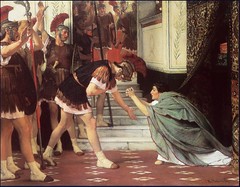
Proclaiming Claudius Emperor by Lawrence Alma-Tadema, c. 1867.
According to the most popular story of Claudius' ascension, he was proclaimed emperor by members of the Praetorian Guard, who found him hiding behind a curtain after the assassination of Caligula in 41 A.D.
what is the foot wear ?
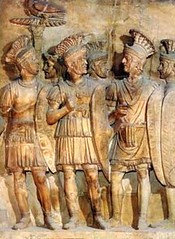
A bas-relief depicting Augustus' Praetorian Guard.
The Praetorian Guard: was a force of bodyguards used by Roman Emperors. Before being appropriated for the use of the Emperors' personal guards, the title was used for the guards of Roman generals, at least since the rise to prominence of the Scipio family around 275 BC. The Guard was dissolved by Emperor Constantine I in the fourth century AD.
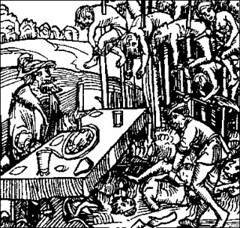
A famous woodcut image of Vlad III dining amidst corpses of the impaled.
Vlad III, Prince of Wallachia (c. 1431 – December 1476), more commonly known as the Impaler or Dracula, was a three-time voivode of Wallachia, ruling mainly from 1456 to 1462. Historically Vlad is best known for his resistance to the Ottoman Empire and its expansion and for the cruel punishments he imposed on his enemies. In the English-speaking world Vlad III is perhaps most commonly known for inspiring the name of the vampire in Bram Stoker's 1897 novel Dracula. - enWikipedia
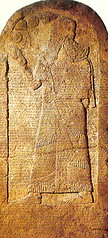
A fairly small image of the Kurkh Monolith.
...an Assyrian document that contains a description of the Battle of Qarqar at the end...The Monolith stands some 2.2 metres tall, and roughly covers years one through six of the reign of Assyrian king Shalmaneser III (859-824 BC), although the fifth year is missing...The Monolith mainly deals with campaigns Shalmaneser made in western Mesopotamia and Syria, fighting extensively with the countries of Bit Adini and Carchemish. At the end of the Monolith comes the account of the Battle of Qarqar, where an alliance of twelve kings fought against Shalmaneser at the Syrian city of Qarqar. This alliance, comprising eleven kings, was led by Irhuleni of Hamath and Hadadezer of Damascus, describing an improbably large force led by King Ahab of Israel. The Monolith is also the first time that the Arabs make an appearance in world history, fielding a contingent containing dromedaries led by King Gindibu. - enWikipedia
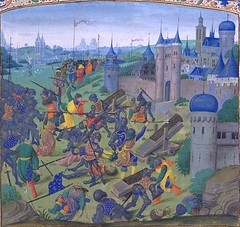
Depiction of the Battle of Nicopolis by Jean Froissart. note: despite their inclusion in the picture, the crusaders did not have siege weaponry with them for this battle
The Battle: ...took place on September 25, 1396, between the Ottoman Empire versus an allied force from the Kingdom of Hungary, France, the Knights Hospitaller, and the Republic of Venice, as well as smaller contingents and individuals from elsewhere in Europe, near the Danubian fortress of Nicopolis, in modern Bulgaria. It is often referred to as the Crusade of Nicopolis and was the last large-scale crusade of the Middle Ages. - enWikipedia
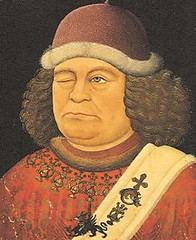
A portrait of Oswald von Wolkenstein (1376 or 1377-1445; poet, composer and diplomat) from the Innsbrucker Handschrift, 1432. In the painting he is seen wearing the Order of the Dragon chain.
The Order: ...was a monarchical chivalric order for selected nobility, created in Hungary in the late Middle Ages. Founded in 1408 by Sigismund, King of Hungary (r. 1397-1437) and later Holy Roman Emperor (r. 1433-1437), the Order primarily flourished in Germany and Italy. According to a surviving copy of its statute, the Order required its initiates to defend the Cross and fight the enemies of Christianity, in particular the Ottoman Turks. - enWikipedia

Frog Tsarevna (Frog Princess) by Viktor Vasnetsov, 1918.
"The Indo-European custom of communal feasts was known as bratchina (from brat, "brother") in Kiev Rus, as slava ("glorification") in Serbia & Macedonia and as sabor ("assembly") in Croatia and Bulgaria." - enWikipedia

Gamayun, one of three prophetic birds of Russian folklore, alongside Alkonost and Sirin (painting by Viktor Vasnetsov, 1897).
Slavic mythology

After Culloden - Rebel Hunting by John Seymour Lucas, 1884.
The painting depicts the intense search undertaken by troops of the British government for Jacobite supporters in the days following the Battle of Culloden.
I've made a couple of lengthier posts about the Battle of Culloden and other aspects of the conflict which caused it...take a look through the archive if you're interested in checking them out; I'm too lazy to search for them at the moment!

The Great Marcus Tullius Cicero (106 BC - 43 BC):
was a Roman philosopher, statesman, lawyer, political theorist, and Roman constitutionalist. He was member of a wealthy family of the equestrian order, and is widely considered one of Rome's greatest orators and prose stylists. Cicero is generally perceived to be one of the most versatile minds of ancient Rome. He introduced the Romans to the chief schools of Greek philosophy and created a Latin philosophical vocabulary, distinguishing himself as a linguist, translator, and philosopher. An impressive orator and successful lawyer, Cicero probably thought his political career was his most important achievement. Today, he is appreciated primarily for his humanism and philosophical and political writings. His voluminous correspondence, much of it addressed to his friend Atticus, has been especially influential, introducing the art of refined letter writing to European culture. Cornelius Nepos, the 1st-century BC biographer of Atticus, remarked that Cicero's letters contained such a wealth of detail "concerning the inclinations of leading men, the faults of the generals, and the revolutions in the government" that their reader had little need for a history of the period. - enWikipedia
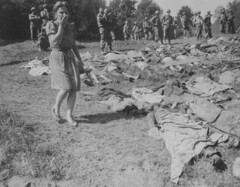
A German girl is overcome as she walks past the exhumed bodies of some of the 800 slave workers murdered by SS guards near Namering, Germany, and laid here so that townspeople may view the work of their Nazi leaders., 05/17/1945" Cpl. Edward Belfer. May 17, 1945. Nara #111-SC-264895.
Denazification: was an Allied initiative to rid German and Austrian society, culture, press, economy, judiciary, and politics of any remnants of the Nazi regime. It was carried out specifically by removing those involved from positions of influence and by disbanding or rendering impotent the organizations associated with it. The program of denazification was launched after the end of the Second World War and was solidified by the Potsdam Agreement.
Collective Guilt Campaign: "[i]n 1945 there was an Allied consensus—which no longer exists—on the doctrine of collective guilt, that all Germans shared the blame not only for the war but for Nazi atrocities as well." Time Magazine, 1969.
Statements made by the British and U.S. governments, both before and immediately after Germany's surrender, indicate that the German nation as a whole was to be held responsible for the actions of the Nazi regime, often using the terms "collective guilt" and "collective responsibility."
To that end, as the Allies began their post-war denazification efforts, the Psychological Warfare Division (PWD) of SHAEF (Supreme Headquarters Allied Expeditionary Force) undertook a psychological propaganda campaign for the purpose of developing a German sense of collective responsibility. The Public Relations and Information Services Control Group of the British Element of the Allied Control Commission began in 1945 to issue directives to officers in charge of producing newspapers and radio broadcasts for the German population to emphasize "the moral responsibility of all Germans for Nazi crimes." Similarly, among U.S. authorities, such a sense of collective guilt was "considered a prerequisite to any long-term education of the German people."
Using the German press, which was under Allied control, as well as posters and pamphlets, a program acquainting ordinary Germans with what had taken place in the concentration camps was conducted. For example using posters with images of concentration camp victims coupled to text such as "YOU ARE GUILTY OF THIS!" or "These Atrocities: Your Fault!" A number of films showing the concentration camps were made and screened to the German public...[the intention] "...was to shake and humiliate the Germans and prove to them beyond any possible challenge that these German crimes against humanity were committed and that the German people – and not just the Nazis and SS – bore responsibility." [PBS]
Immediately upon the liberation of the concentration camps many German civilians were forced to see the conditions in the camps, bury rotting corpses and exhume mass-graves. On threat of death or withdrawal of food, civilians were also forced to provide their belongings to former concentration camp inmates. - enWikipedia
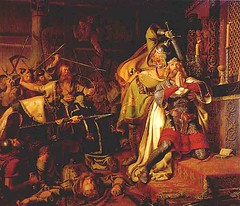
Knud den Helliges drab (The Murder of Canute the Holy) by Christian Albrecht von Benzon, c. 1843.
Canute IV: was the illegitimate son of Sweyn II Estridsson. Before he became king of Denmark, the Anglo-Saxon Chronicle reports that Canute was one of the leaders of a Viking raiding expedition against England in 1075. On its return from England, the Danish raiders' fleet stopped in the County of Flanders. Because of its hostility toward William I of England, Flanders was a natural ally for the Danes.
In 1080, Canute succeeded his brother, Harald III, to the throne of Denmark. On his accession, he married Adela, daughter of Robert I, Count of Flanders. She bore him one son, Charles, a name uncommon in Denmark. The boy later became Count of Flanders and was known as Charles the Good, ruling from 1119 to 1127. Like his father, he was martyred in a church by rebels (in Bruges in 1127).
Canute quickly proved himself to be a highly ambitious king as well as a devout one. His reign was marked by vigorous attempts to increase royal power in Denmark. He issued edicts arrogating to himself the ownership of common land, the right to the goods from shipwrecks, and the right to inherit the possessions of foreigners and kinless folk. Ever a champion of the Church, he also issued laws to protect the weak, orphans, widows, and foreigners, and tried to enforce the collection of tithes. These policies led to discontent among his subjects, who were unaccustomed to a king who claimed such powers and who interfered in their daily lives.
But Canute's ambitions were not purely domestic. As the grandnephew of Canute the Great, who until 1035 was king of England, Denmark and Norway, this Canute considered the crown of England to be rightfully his. He therefore regarded William I of England as a usurper. In 1085, with the support of his father-in-law Count Robert, Canute planned an invasion of England. He assembled a fleet at Limfjord, but it never set sail. Possibly Canute was wary of intervention by Henry IV, Holy Roman Emperor, with whom both Denmark and Flanders were on unfriendly terms. Certainly Canute was suspicious of his brother Olaf (later Olaf I of Denmark), who sought command of the fleet, and had him arrested and sent to Flanders. The fleet then dispersed, but Canute intended to reassemble it in a year's time.
Before the fleet could reassemble, a peasant revolt broke out in southern Jutland, where Canute was staying, in early 1086. Canute and his men took refuge inside the wooden Church of St. Alban's in Odense. But the rebels stormed into the church and slew Canute, along with his brother Benedict and seventeen of their followers, before the altar on July 10, 1086. According to Niels Lund, Lecturer in Medieval History at the University of Copenhagen, Canute's abortive invasion of England "marked the end of the Viking Age." For it was the last time a Viking army was to assemble against Western Europe. - enWikipedia